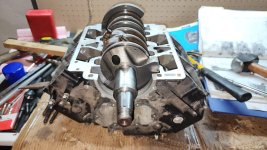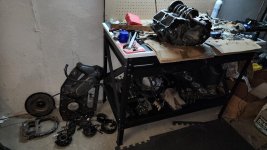JamesDTaylorSTL
Cadet
- Joined
- Jul 17, 2023
- Messages
- 11
A few pics below but I have a LOT more as I read the manual and took lots of pics and notes to help with reassembly. So if you want to see something I probably have a pic of it! (Hopefully, most of you guys can read all of this on a PC and not a tiny phone screen!
I have experience rebuilding 2-stroke dirtbikes but no multi-cylinder engines. Per below the compression check seemed decent for a cold engine that hasn't seen use in some time. My problem is the lower, starboard cylinder keeps filling with gas as I crank the engine. I rebuilt the carbs so, unfortunately, a simple stuck float was causing the port side bottom cylinder (90% sure that one...) to fill with gas. At first, it started to seem like it was trying to start but as more gas was let in, it started to slow due down due to the lessening cylinder air volume. I would eventually get a hydro-lock but only when turning it by hand so I don't think any damage was done like a bent rod. It actually turns over nice and smooth and the pistons and bores (what's visible of them at this point with the crank still) in look great. So hopefully just needs rings, cleaning, and fixing the gas leak. Even the impeller and housing look great.
But I didn't want to go any farther until I thoroughly read the 5-6 pages of all the things to check when taking the crank/pistons out AND asked what to look for on here as the manual doesn't seem to even address this kind of cylinder fuel leak!
So my basic knowledge of multi-cylinder 2-stokes is that there are crank seals between each cylinder so the fueling/exhaust cycles are kept separate. I guess these are the big thick metal rings ("Seal Ring" - 319244?) that do that. (anything else?) Nothing obvious yet but again the crank/pistons are still in. I did see one very small "dent" on a ring landing that looked like it might cause a small leak. I haven't totally removed/checked the leaf valves to see all surfaces but to me they look like new. What else should I look for? I'd really like to find something bad so I feel pretty confident I fixed it!
So assuming I fix the leaking cylinder problem, I'm going to change the piston rings and I guess hone the so-far, perfect-looking cylinders(?). And maybe replace all of the gaskets and whatever else it says to in this section of the manual.
I'll probably need more but should I start by buying this seal kit on Amazon? - https://www.amazon.com/dp/B07VX66BM4/
Do I really need a crank screw OMC Alignment Fixture #396749 considering I hope I never have to do this again...? I know they like to sell their "special parts" but $40 for a crank screw socket I got off of Amazon for $7 is ridiculous. What OMC equivalent assembly lubes can I use?
Do I need all of these kits the manual mentions?
Powerhead Gasket Kit
Fuel Pump Repair Kit
Exhaust Filler Block Replacement Kit
Inlet HSG. Seal Kit
Flushing Kit
Impeller HSG. Seal Kit
Exhaust Filler Block Replacement Kit
Well thanks in advance for any help. I hope to be putting the engine back in by the end of the month!
James (Jim) Taylor
Maryland Heights, MO
--------------------------------------------------------------------------
(As mentioned, I posted this (link below) last year before the rebuild but while I don't think much relates to the problem, some background may be useful.) (https://forums.iboats.com/threads/i...l-startup-and-troubleshooting-attempt.768708/)
I have experience rebuilding 2-stroke dirtbikes but no multi-cylinder engines. Per below the compression check seemed decent for a cold engine that hasn't seen use in some time. My problem is the lower, starboard cylinder keeps filling with gas as I crank the engine. I rebuilt the carbs so, unfortunately, a simple stuck float was causing the port side bottom cylinder (90% sure that one...) to fill with gas. At first, it started to seem like it was trying to start but as more gas was let in, it started to slow due down due to the lessening cylinder air volume. I would eventually get a hydro-lock but only when turning it by hand so I don't think any damage was done like a bent rod. It actually turns over nice and smooth and the pistons and bores (what's visible of them at this point with the crank still) in look great. So hopefully just needs rings, cleaning, and fixing the gas leak. Even the impeller and housing look great.
But I didn't want to go any farther until I thoroughly read the 5-6 pages of all the things to check when taking the crank/pistons out AND asked what to look for on here as the manual doesn't seem to even address this kind of cylinder fuel leak!
So my basic knowledge of multi-cylinder 2-stokes is that there are crank seals between each cylinder so the fueling/exhaust cycles are kept separate. I guess these are the big thick metal rings ("Seal Ring" - 319244?) that do that. (anything else?) Nothing obvious yet but again the crank/pistons are still in. I did see one very small "dent" on a ring landing that looked like it might cause a small leak. I haven't totally removed/checked the leaf valves to see all surfaces but to me they look like new. What else should I look for? I'd really like to find something bad so I feel pretty confident I fixed it!
So assuming I fix the leaking cylinder problem, I'm going to change the piston rings and I guess hone the so-far, perfect-looking cylinders(?). And maybe replace all of the gaskets and whatever else it says to in this section of the manual.
I'll probably need more but should I start by buying this seal kit on Amazon? - https://www.amazon.com/dp/B07VX66BM4/
Do I really need a crank screw OMC Alignment Fixture #396749 considering I hope I never have to do this again...? I know they like to sell their "special parts" but $40 for a crank screw socket I got off of Amazon for $7 is ridiculous. What OMC equivalent assembly lubes can I use?
Do I need all of these kits the manual mentions?
Powerhead Gasket Kit
Fuel Pump Repair Kit
Exhaust Filler Block Replacement Kit
Inlet HSG. Seal Kit
Flushing Kit
Impeller HSG. Seal Kit
Exhaust Filler Block Replacement Kit
Well thanks in advance for any help. I hope to be putting the engine back in by the end of the month!
James (Jim) Taylor
Maryland Heights, MO
--------------------------------------------------------------------------
(As mentioned, I posted this (link below) last year before the rebuild but while I don't think much relates to the problem, some background may be useful.) (https://forums.iboats.com/threads/i...l-startup-and-troubleshooting-attempt.768708/)






















